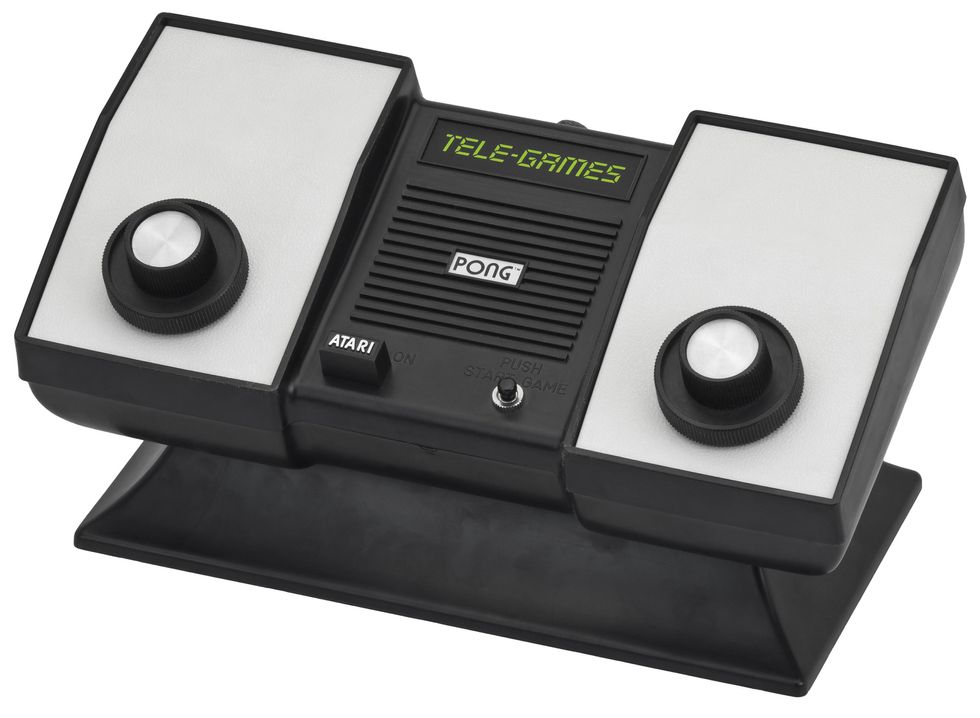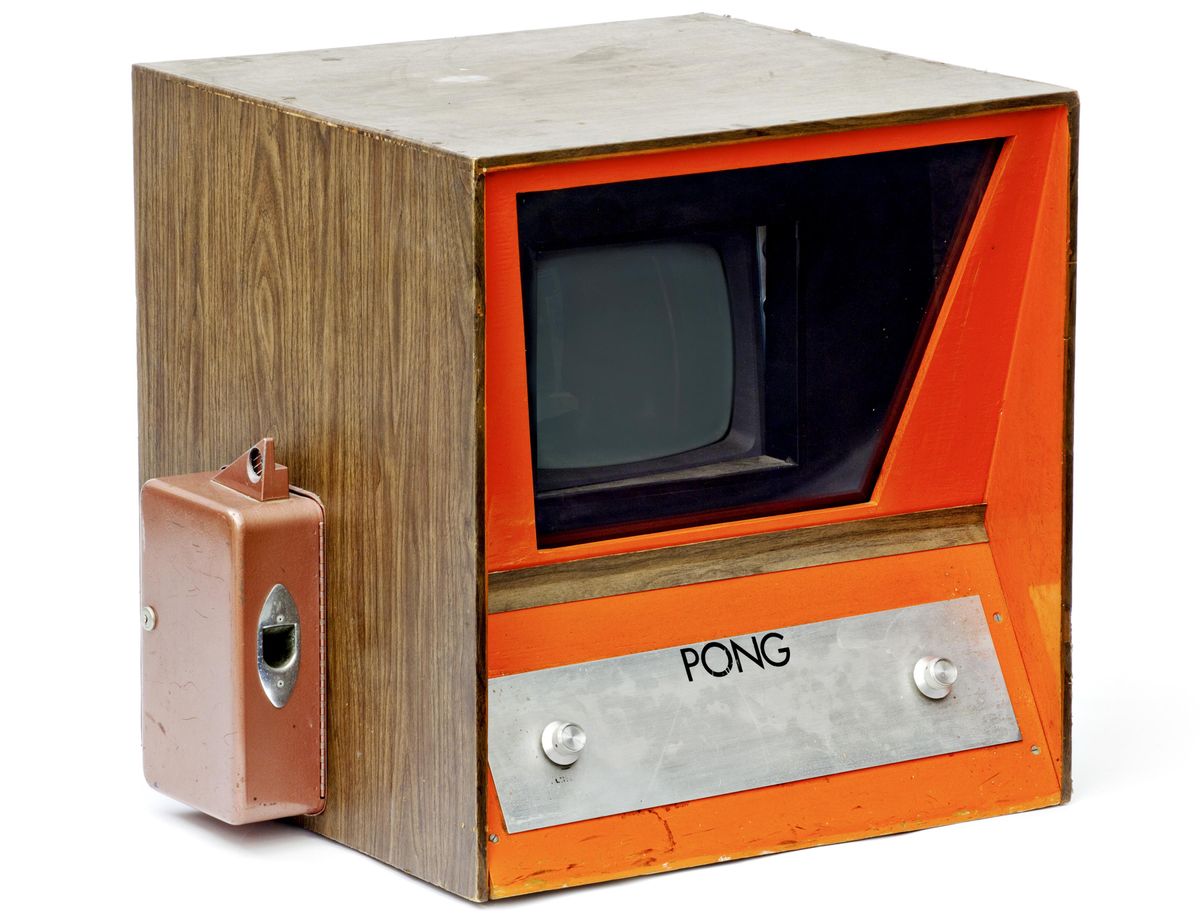November marks the 50th anniversary of Pong. Why should we care?
For starters, Pong is the first video game that millions of people welcomed into their homes to play on their own televisions. Pong kick-started a global video-game industry that is now worth upwards of US $300 billion. And Pong still has a place in active research, for training AI algorithms, strengthening neural networks, and developing the brain-machine interface called Neuralink, among other things.
And yet as a Gen-Xer born too late to have enjoyed Pong as a child, I have trouble fathoming how anyone could sit in front of a TV watching a square dot—not even a round ball—bounce back and forth across the dark, featureless screen. Was this really fun? To celebrate the half-century persistence of Pong, I set out to discover why so many people love the most boring video game of all time.
What is Pong?
In case you have somehow never encountered Pong, it is simplicity itself—represented on screen as a moving dot, two vertical lines with which to hit the dot, and squared-off digits reflecting the score. The game mimics table tennis, with two people competing against each other to get the ball past their opponent. Players can move their paddle vertically (but not horizontally) to deflect the ball, and the ball can also bounce off the top and bottom of the screen. The ball speeds up the longer you rally, and each hit is accompanied by a satisfying “click” sound. If you miss, your opponent scores a point. The first player to reach 11 points wins.

The game was actually created as part of a training exercise to get a young engineer named Allan Alcorn acquainted with video-game development. Nolan Bushnell and Samuel “Ted” Dabney had recently started Atari, and they hired Alcorn as their third employee. Alcorn had majored in electrical engineering and computer science at the University of California, Berkeley, but had never played a video game before. At the time, video games were mostly the domain of research laboratories and universities. Under the guise of a contract for General Electric, Bushnell asked Alcorn to design a game similar to ping-pong that could be played on a television.
Because Pong was developed before the debut of microcontrollers, the circuit board consisted of hardwired, discrete logic components. The arcade version included 66 integrated circuits, a pair of 555 timers, and a few transistors. (For a deeper dive into Pong’s design, see Hugo Holden’s article, “Atari Pong E Circuit Analysis & Lawn Tennis: Building a Digital Video Game with 74 Series TTL IC’s,” Dan Boris’s redraw of the circuit diagram, and Ricardo Ramos’s account of building a Pong clone.)
To celebrate the half-century persistence of Pong, I set out to discover why so many people love the most boring video game of all time.
Bushnell understood the economics of pinball machines and other arcade games, and so he decided to add a coin box to the Pong arcade console [pictured at top]. He beta tested it at Andy Capp’s Tavern in Sunnyvale, Calif. According to Pong lore, people lined up for their turn to stuff quarters into the machine and play. Eventually, the manager called Alcorn because the coin box was jammed to overflowing and the game had stopped working.
Atari sold about 35,000 consoles for use in arcades, bars, and restaurants, but the real game changer, as it were, didn’t happen until 1975, when Atari introduced Home Pong, for play on your own TV set. The controller was a brown box with a dial on each side, forcing players to play shoulder to shoulder. It was advertised as working with any television set, but you could only play the one game. Later versions had individual controllers with long cords that allowed players to sit back more comfortably. Hundreds of thousands of Pong sets were distributed through the department store Sears. The game was also one of the original titles included with the Atari 2600, a video-game system introduced in 1977 that let you play different games by swapping out the game cartridge.

Meanwhile, Atari had to contend with the problems of Pong’s popularity. Back in 1972, Magnavox had introduced its Odyssey home video-game system, which included a game called Table Tennis. Two years later, it filed a lawsuit against Atari alleging copyright infringement; that suit was settled out of court. Rival companies brought out similar Pong-like games, as did Atari itself. Bushnell wanted a one-player Pong-type game, so he worked with Steve Bristow and Steve Wozniak to develop Breakout, a brick-breaking game that also proved wildly popular. In 2015, the Strong National Museum of Play, in Rochester, N.Y., inducted Pong into its World Video Game Hall of Fame, citing its popularity and influence in launching the video-game industry.
Pong was not the first video game, nor the first table-tennis video game, nor the first home video game, and yet it was the one that introduced millions of children and their parents to the idea of video gaming.
But was Pong fun?
I first encountered Pong in the early 1980s, on an Atari 2600 at my kindergarten best friend’s house. I didn’t see the magic then, and I still don’t. How was this the game that launched a billion-dollar industry? I recently posed this question to friends of a certain age and was surprised to receive a resounding chorus of cheers for Pong. Yes, Pong really was fun! My curiosity piqued, I followed up with some informal interviews and an entirely unscientific sampling methodology, and I have compiled the top five reasons people seem to love Pong.
Above all, the novelty factor seems to propel Pong to the top of the pantheon of video games. David C. Brock, director of curatorial affairs at the Computer History Museum, fondly remembered playing Pong at home and in a restaurant in Pennsylvania. Pong was so new and different that it made an impression, Brock recalls. Pinball may literally have all the bells and whistles, but it was a game from the previous century. Pong was the future, even if that future was a black-and-white television screen.
Top 5 Reasons People Love Pong
1. Novelty
2. Sociability
3. Calming Effect (ASMR)
4. The Challenge
5. Nostalgia
Connected to the novelty factor is that Pong is an inherently social game. No longer were players competing one by one to get the highest score. Now you could compete directly against your friends and family. My University of South Carolina colleague James Risk grew up in Mooresville, Indiana, a small town southwest of Indianapolis. His house was the first in the neighborhood to have a home version of Pong. James’s father would never relinquish his turn, even when he lost, so James and his siblings had to duke it out to be Player 2. Even the family cat would get into the action, chasing the moving dot on the screen.
Lynn Heidelbaugh, a museum curator in Washington, D.C., remembers watching her older brothers play Pong. She found the game mesmerizing—watching the ball move back and forth, bouncing at angles off the paddles, each hit accompanied by a satisfying chirp. It’s not a stretch to think that Pong induces autonomous sensory meridian response, or ASMR, the calming and euphoric feeling triggered by repetitive auditory or visual stimuli. Pong’s distinctive sound was Alcorn’s response to Bushnell’s request for the roar of crowds. Alcorn crafted the sound from tones that already existed in the sync generator.
Despite the simplicity of the game, Pong was surprisingly challenging to play. The controllers were not particularly sensitive, and it was easy to miss a ball you thought you had. For many players, this imperfection made the game addictive, as they kept trying to improve. Another defect (or feature, as Alcorn preferred to think of it) was that the paddles did not move fully to the top or bottom of the screen. This was due to a problem in the circuitry. Alcorn could have fixed it, but it turned out to be a happy accident. Had the paddles reached the edges, really good players could have rallied indefinitely. Instead, the game inevitably ends after a few minutes, only to be started again by gamers intent on winning.
A final reason people love Pong is nostalgia, whether that’s a recalling of childhood memories or a wistfulness for a past they never had. Katherine Lewandowski, now a geologist at Eastern Illinois University, didn’t play much Pong growing up, but was reintroduced to the game as an undergraduate at Vanderbilt in the 1990s. She says she was a novice compared to her friends, who had been playing for years, but she still enjoyed a spin at the console at Obie’s Pizza while waiting for their deep dish.
IEEE Spectrum’s special projects editor Stephen Cass grew up in Ireland. By the time arcade games arrived there, Cass says, Pong was not among the offerings—manufacturers had already moved on to other titles. His strongest Pong memory is thus not of the game but of the 1994 Frank Black song “Whatever Happened to Pong?,” which leveraged the ’90s trend of ’70s nostalgia. A few years later, Pong made a recurring appearance on season 1 of That ’70s Show, thereby cementing the nostalgia.
For me, though, Pong doesn’t hold a candle to Frogger. My father, who was an early adopter of almost all things tech, never saw value in video games, so I had to run down the street to my friend’s house to play Frogger on her Atari. I love that pixelated frog and the many ways to die—I was not particularly good at the game and died frequently. To this day, references to Frogger inevitably surface whenever I make ill-timed attempts at jaywalking in the city.
I suspect that every generation of the past half century has its game, the one that introduced them to video games, that triggers waves of nostalgia and fond memories, the old favorite that people are excited to see when they serendipitously encounter it in a pizza parlor or on an emulator in a museum. It could be Pong or Frogger or Pac-Man or Tetris or Super Mario Bros. or Space Invaders—or the next big thing! What game do you think we will be talking about in 50 years?
Part of a continuing serieslooking at photographs of historical artifacts that embrace the boundless potential of technology.
An abridged version of this article appears in the November 2022 print issue as “In Praise of Pong.”
Allison Marsh is a professor at the University of South Carolina and codirector of the university's Ann Johnson Institute for Science, Technology & Society. She combines her interests in engineering, history, and museum objects to write the Past Forward column, which tells the story of technology through historical artifacts. She is the 2024-25 National Endowment for the Humanities Fellow at the Linda Hall Library for Science, Technology, and Engineering, where she is researching the history of women in electrical engineering.



